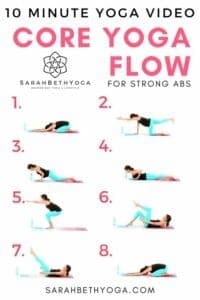If you’re aiming to fortify your core and sculpt your abs, this article is your perfect guide. We’ve curated eight indispensable yoga poses that target core muscles effectively. Through a blend of dynamic actions and sustained holds, these poses not only focus on your abdominal region but also enhance balance and overall body strength. Accessible to beginners yet challenging for seasoned yogis, these core-centric poses are set to redefine your physique. So, grab your mat and brace yourself for an exhilarating core-focused yoga session.
Core strengthening yoga postures focus on fortifying the abdominal muscles and those that support the lower back and pelvis. These poses, or asanas, are crucial in any yoga routine as they help maintain stability and balance in our bodies.
Activating Uddiyana Bandha, or the abdominal lock, is essential for maintaining a strong and stable core during these exercises. It’s beneficial to practice drawing your belly button inward and upward as a separate movement to train your muscles in the correct form before integrating it into core strength poses. Over time, you might find it useful to apply this bandha throughout your entire yoga session.
For beginners in core strengthening, it’s advisable to start with basic poses. These are simpler and quicker to execute than more advanced ones. As you grow more accustomed to the basics, you can gradually introduce intermediate poses. Integrating core strengthening poses into your yoga practice in short sets distributed throughout is the most effective approach. This method allows you to build strength steadily and safely. Remember to always listen to your body and make modifications when needed.
Proper alignment and muscle engagement are crucial when learning core strengthening yoga poses. If you experience any pain or discomfort in your lower back while practicing these asanas, you should stop immediately.
Benefits of Core Strengthening Poses
The primary advantage of core strengthening yoga poses is enhanced balance and stability. Strengthening your core muscles improves your ability to maintain proper posture and remain steady in various yoga poses. This not only makes it easier to perform more complex yoga poses but also lowers the risk of falls and potential injuries during yoga sessions. These poses also boost self-confidence and overall strength.
Additionally, practicing core strengthening yoga poses can lead to increased flexibility. Your core muscles are integral in maintaining spinal alignment and flexibility, and they contribute to various movements beyond yoga. For overall strong and flexible muscles, incorporating core strengthening yoga poses into your daily routine is beneficial.
Guidelines for Safe Core Strengthening in Yoga
Warm-Up is Crucial: Before diving into any demanding asana, it’s important to warm up. This reduces the risk of muscle strain and soreness.
Start Slowly: Initially, take your time with each pose, focusing on perfecting the movements. In the beginning, limit yourself to one set of core strengthening poses per session.
Breathing Matters: Avoid holding your breath during these exercises. Continuous, deep breathing is key to maintaining relaxation while engaging in challenging core poses. Holding your breath can elevate stress levels and increase the risk of muscle strain.
Experiment with Variations: Try different versions of core strengthening poses to discover what suits you best. Experimenting helps in targeting all core muscles effectively.
Be Patient and Gradual: If you’re new to core yoga poses, understand that building strength and proficiency takes time. Start with less intensity and gradually increase as you become more comfortable.
Avoid Overexertion: If your core muscles are initially weak, it’s important to strengthen them gradually. Overdoing exercises can lead to excessive soreness.
Listen to Your Body: If you feel any discomfort or pain during a pose, stop immediately and, if necessary, consult a healthcare professional.
Brief Descriptions of Core Strengthening Yoga Poses
Mountain Pose: This foundational pose focuses on grounding and stability, engaging the core muscles to maintain an upright, balanced posture.
Plank Pose: A powerful pose for core strengthening, Plank Pose challenges your entire body, emphasizing abdominal strength and endurance.
Cat-Cow Stretch: This gentle flow between two poses improves flexibility in the spine and neck, while also engaging and strengthening the core muscles.
Hands and Knees Balance: This pose enhances coordination and balance, requiring core engagement to maintain stability while limbs are extended.
Down Dog Splits: A variation of the classic Downward Dog, this pose not only stretches the body but also strengthens the core as you lift and extend one leg.
Side Plank Pose – Vasisthasana: This challenging pose targets the obliques and shoulders, requiring significant core strength for balance and alignment.
High Lunge: This dynamic pose strengthens the lower body while engaging the core muscles for balance and stability.
Chair Pose – Utkatasana: Known for its ability to build strength in the thighs and ankles, Chair Pose also engages the core muscles as you maintain an upright torso.
Boat Pose – Navasana: An intense pose that directly targets the abdominal muscles, Boat Pose requires and builds deep core strength and balance.
Each of these poses offers unique benefits for core strengthening, contributing to overall stability, balance, and posture in your yoga practice.
Conclusion
Incorporating these core strengthening yoga poses into your practice can significantly enhance your overall physical health and yoga experience. Not only do they build strength in the core muscles, but they also improve balance, stability, and flexibility. Remember, the key to a successful and safe practice is to listen to your body, progress at your own pace, and maintain proper form and breathing techniques. With regular practice, these poses can help you develop a stronger, more resilient body and a focused, calm mind.
Disclaimer
The content is purely informative and educational in nature and should not be construed as medical advice. Please use the content only in consultation with an appropriate certified medical or healthcare professional

